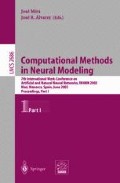Abstract
Life-long learning paradigm accentuates on the continuity of the on-line process of integrating novel information into the existing representational structures, and recategorization or update of these structures. This paper brings up the hypothesis, that memory consolidation is a biological mechanism that resembles the features of life-long learning paradigm. A global model for memory consolidation is proposed on a functional level, after reviewing the empirical studies on the hippocampal formation and neocortex. Instead of considering memory as storage, the proposed model reconsiders ]the memory process as recategorization. Distinct experiences that share a common clement can be consolidated in the memory in a way such that they arc substrata for a new solution. The model is applied to an autobiographical robot.
Access this chapter
Tax calculation will be finalised at checkout
Purchases are for personal use only
Preview
Unable to display preview. Download preview PDF.
References
Barakova E.I. and U. R. Zimmcr, Dynamical Situation and Trajectory Discrimination of Raw Range Measurements, AISTA, Canberra, Feb. 2000.
Cohen NJ and Eichenbaum H, Memory, amnesia and the hippocampal system. Cambridge, MA: MIT Press, 1995.
Conway, M. A., & Bekerian, D. A. (1987). Organization in autobiographical memory. Memory & Cognition, 15,119–132.
Pavlides C, Greenstein YJ, Grudman M, Winson J., Long-term potentiation in the dentate gyms is induced preferentially on the positive phase of theta-rhythm. Brain Res 1988, 439:383–387.
Izquierdo I, Medina JH, Memory formation: the sequence of biochemical events in the hippocampus and its connection to activity in other brain structures. Neurobiol. Learning and Memory 1997, 68:285–316.
Frizke, B. (1995). A growing neural gas network learns topologies. Advances in Neural Information Processing Systems 7. MIT Press, Cambridge MA.
Fuster, J.M. Memory in the Cerebral Cortex. MIT Press, 1994.
Kali S, Dayan P. 2000. Hippocampally-dependent consolidation in a hierarchical model of neocortex. NIPS 2000:24–30.
Lavenex P. and David G. Amaral, Hippocampal-Neocortical Interaction: A Hierarchy of Associativity, Hippocampus 10:42–430 (2000).
Martinetz, T., & Schulten, K. (1991). A neural-gas network learns topologies. In T. Ko-honen at al. (Eds.), (pp. 397–402). Proc. of ICANN, Amsterdam, Netherlands.
McClelland JL, McNaughton, B.L., O’Reilly, R.C. Why there are complementary learning systems in the hippocampus and neocortex. Psychol. Rev. 1995, 102, 419–457
Marr D: Simple memory: a theory of archicortex. Philos Trans R Soc Lond B 1971, 262:23–81.
McClelland JL and Goddard, NH,1997. Considerations arising from a complementary learning systems perspective on hippocampus and neocortex. Hippocampus, 6:654–665.
Miller, R. Cortico-hippocampal interplay: Self-Organized, Phase-locked loops for Indexing Memory, Psychobiology, Vol. 17(2), 115–128, 1989.
O’Keefe, J. and Recce M., 1993, Phase relationship between hippocampal place units and the EEG theta rhythm. Hippocampus, 3:317–330.
Squire, L. R. Memory and the hippocampus: A synthesis from findings with rats, monkeys, and humans. Psychological Review, 99:195–231, 1992.
Sutherland, G.R. and McNaughton, B. (2000) Memory trace reactivation in the hippocampal and neocortical neuronal ensembles. Curr. Opin. Neurobiol. 10, 180–186
Swanson, L.V., Kohler, C. and Bjorklund A. The limbic region: I:The septohippocampal system. In A. Bjorklund, T. Hokfeld, and L.W. Swanson, edt. Handbook of chemical neu-roanathomy, Vol. 5, pages 125–277. Elsevier, 1987.
Rubin, D. C. (Ed.). (1996). Remembering our past: Studies in autobiographical memory. New York: Cambridge University Press.
Thrun, S.B., and T. M. Mitchell. Integrating inductive neural network learning and explanation-based learning. Tn Proceedings ofIJCAI-93, Chamberry, France, 1993.
Wiener, S.I., V. Korshunov, R. Garcia, and A. Berthoz, 1995. Internal, sibstratial and landmark que control of hippocampal CA1 place cell activity. European Journal of Neuro-science, 7:2206–2219, 1995
Yamaguchi, Y., 2003. A Theory of Hippocampal Memory Basedon Theta Phase Precession Biological Cybernetics, Tn press.
Author information
Authors and Affiliations
Editor information
Editors and Affiliations
Rights and permissions
Copyright information
© 2003 Springer-Verlag Berlin Heidelberg
About this paper
Cite this paper
Barakova, E.I., Lourens, T., Yamaguchi, Y. (2003). Life-long learning: consolidation of novel events into dynamic memory representations. In: Mira, J., Álvarez, J.R. (eds) Computational Methods in Neural Modeling. IWANN 2003. Lecture Notes in Computer Science, vol 2686. Springer, Berlin, Heidelberg. https://doi.org/10.1007/3-540-44868-3_15
Download citation
DOI: https://doi.org/10.1007/3-540-44868-3_15
Published:
Publisher Name: Springer, Berlin, Heidelberg
Print ISBN: 978-3-540-40210-7
Online ISBN: 978-3-540-44868-6
eBook Packages: Springer Book Archive

